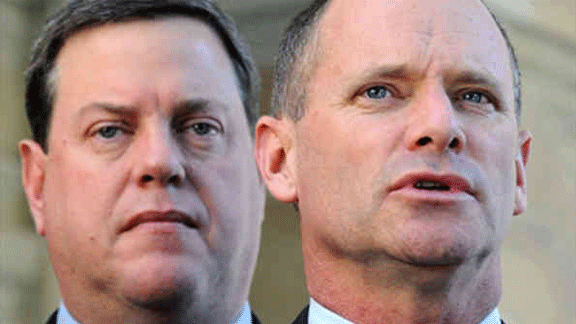Queensland budget shows LNP priorities

Queensland Treasurer Tim Nicholls has delivered the LNP’s third and final budget before the next state election, due early in 2015. The centrepiece is plans to privatise or lease $33.6 billion worth of government assets, including power generators and ports.
The government is arguing that it has no choice – vital projects including public transport developments are dependent on the funds being raised. However unions have rejected the sales, arguing that it will cost further public sector jobs on top of the thousands lost in the LNP’s previous two budgets – as well as continue the trend toward soaring electricity costs.
In a further demonstration of government priorities, and consistent with attacks on the most vulnerable in previous budgets, the government is using reduced federal government funding as a reason for cutting back on pensioner concessions for rates, power and water bills and public transport costs. Queensland Council of Social Service has described the cuts to concessions as “a dark cloud on the horizon” that “would have a significant impact on tens of thousands of seniors living on or below the poverty line”. Many Queensland pensioners are justifiably distraught at the impact this move will have on their already shrinking budgets.
The government has made much fuss about funding “increases” to key agencies, including the allocation of $400 million over five years to implement recommendations of an inquiry into the child protection system. Premier Campbell Newman argued that the funding would “allow us to overhaul the child protection system and help make Queensland the safest place in Australia to raise a child”. However as the public sector union has pointed out, this needs to be considered in the context of a system that is chronically underfunded and with massive caseloads for a workforce that felt the brunt of public sector job cuts in previous budgets.
Similar cynicism needs to be applied to government claims that funding to health and education is being maintained or expanded. According to initial analysis by the Queensland Teachers Union, for example, government figures showing a 7 percent increase to the sector, including 761 additional teachers and teacher aides, will be insufficient to keep up with projected enrolment figures, with the result inevitably being bigger class sizes.
Likewise the 6.4 percent increase to health funding needs to be offset against the reality that the public health system in Queensland is chronically underfunded, with thousands of jobs – including frontline positions such as nurses and midwives – being lost since the election of the LNP in 2012. Those lucky enough to have kept their jobs are overworked and looking over their shoulders in fear of the next round of cuts.
However it is the massive sell-off of public assets that represents the biggest concern to many, who recall that the previous Labor government was turfed out in a landslide due largely to anger over its selling of state assets. Most Queenslanders are opposed to further asset sales, with a government “Strong Choices” media campaign failing dismally to convince voters of the supposed benefits.
On a government website calling for public comment, the bulk of the 50,000 respondents rejected the plan, with most favouring an increase in state taxes over asset sales. State taxation revenue is forecast at $12.5 billion for the 2014/15 financial year, which the government argues is insufficient to service debt and pay for key infrastructure projects.
However, it’s not as if there isn’t more potential revenue available should the government choose to go after it. According to the Australian Bureau of Statistics, Australian gross company profits rose by 3.1 percent to $70.8 billion dollars in the March quarter, as part of an annual increase to 11 percent. In the mining sector alone, profits rose by 27 percent in the twelve months to March – and much of this was generated in Queensland.
Even if there were a “budget crisis”, a highly dubious claim, the fact that both state and federal governments prefer attacking workers and the disadvantaged to service debt, rather than look to those who are living high on the hog tells us much about the class bias in their approach to fiscal policy. No surprise then that the Chamber of Commerce and Industry Queensland has welcomed the budget, being particularly pleased “that the government had resisted the temptation to lift or introduce new taxes on business”.
Unions have promised to fight the asset sales. However with a state election looming, Ros McLennan from the Queensland Council of Unions declared that “the only thing that will make them listen is the ballot box”. It would be a major concern if the primary strategy for opposing the government’s agenda was to focus on having them thrown out of office. Firstly, despite their fall in popularity they still maintain an overwhelming majority in parliament and a change of government, though possible, seems unlikely. Furthermore, even if Labor were to be re-elected, there is no guarantee they would deliver, given their record in office.
If we want to stop the asset sales, along with the ongoing attacks on working class and vulnerable Queenslanders that have marked this government, we need to be taking a leaf from unions interstate who are mobilising in response to the horror federal budget. Or from the university students across the country who have been at the forefront of putting the Liberals on the back foot through inspirational street marches and by demonstrating everywhere they show their faces. We need a fight in the here and now that draws on the strengths of our side with further mobilisations and with industrial action from the very workers likely to be most affected by this budget.